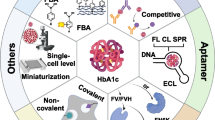Abstract
Tissue functions such as hormone secretion involve the interplay of multiple chemical signals and metabolic processes over time. Measuring the different components involved is useful in unraveling the interactions, but often requires use of multiple analytical techniques. The challenge of measuring the necessary components with temporal resolution is greater when tissue samples are limited. Here, an accessible microfluidic platform compatible with multiple measurement techniques to monitor cell secretions has been developed. The platform is applied to islets of Langerhans, micro-organs involved in glucose homeostasis and diabetes. The device houses 1 to 8 islets and the perfusion fluid can be controlled to change conditions, e.g., glucose concentration, in seconds. Samples are collected in fractions and split for offline analysis. The device is paired with a scaled-down immunoassay, AlphaLISA, for hormone quantification and liquid chromatography-mass spectrometry for small molecule quantification to study secretion dynamics. The combined system allows the first simultaneous measurement of insulin, glucagon, biogenic amines, and amino acids from islet secretions. The combined measurements revealed correlation in secretion events and differences in timing of release between hormones and biogenic amines and amino acids. These efforts decreased the number of islets required compared to standard approaches, thus decreasing necessary animal use, reagent use, and cost, while increasing information content achievable from one sample. The microfluidic device is a suitable platform for in-depth characterization of secretion from small tissue samples.
Graphical abstract








Similar content being viewed by others
References
Henquin JC. Triggering and amplifying pathways of regulation of insulin secretion by glucose. Diabetes. 2000;49:1751–60. https://doi.org/10.2337/diabetes.49.11.1751.
Habegger KM, Heppner KM, Geary N, Bartness TJ, DiMarchi R, Tschöp MH. The metabolic actions of glucagon revisited. Nat Rev Endocrinol. 2010;6:689–97. https://doi.org/10.1038/nrendo.2010.187.
Gromada J, Chabosseau P, Rutter GA. The α-cell in diabetes mellitus. Nat Rev Endocrinol. 2018;14:694–704. https://doi.org/10.1038/s41574-018-0097-y.
Gilon P. The role of α-cells in islet function and glucose homeostasis in health and type 2 diabetes. J Mol Biol. 2020;432:1367–94. https://doi.org/10.1016/j.jmb.2020.01.004.
Henquin J-C. Paracrine and autocrine control of insulin secretion in human islets: evidence and pending questions. Am J Physiol-Endocrinol Metab. 2021;320:E78-86. https://doi.org/10.1152/ajpendo.00485.2020.
Li C, Liu C, Nissim I, Chen J, Chen P, Doliba N, et al. Regulation of glucagon secretion in normal and diabetic human islets by γ-hydroxybutyrate and glycine. J Biol Chem. 2013;288:3938–51. https://doi.org/10.1074/jbc.M112.385682.
Di Cairano ES, Moretti S, Marciani P, Sacchi VF, Castagna M, Davalli A, et al. Neurotransmitters and neuropeptides: new players in the control of islet of Langerhans’ cell mass and function: paracrine signals in the endocrine pancreas. J Cell Physiol. 2016;231:756–67. https://doi.org/10.1002/jcp.25176.
Satin LS, Kinard TA. Neurotransmitters and their receptors in the islets of Langerhans of the pancreas: what messages do acetylcholine, glutamate, and GABA transmit? Endocrine. 1998;8:213–24. https://doi.org/10.1385/ENDO:8:3:213.
Cabrera O, Jacques-Silva MC, Speier S, Yang S-N, Köhler M, Fachado A, et al. Glutamate is a positive autocrine signal for glucagon release. Cell Metab. 2008;7:545–54. https://doi.org/10.1016/j.cmet.2008.03.004.
Inagaki N, Kuromi H, Gonoi T, Okamoto Y, Ishida H, Seino Y, et al. Expression and role of ionotropic glutamate receptors in pancreatic islet cells. FASEB J. 1995;9:686–91. https://doi.org/10.1096/fasebj.9.8.7768362.
Braun M, Ramracheya R, Bengtsson M, Clark A, Walker JN, Johnson PR, et al. γ-Aminobutyric acid (GABA) is an autocrine excitatory transmitter in human pancreatic β-cells. Diabetes. 2010;59:1694–701. https://doi.org/10.2337/db09-0797.
Yan-Do R, Duong E, Manning Fox JE, Dai X, Suzuki K, Khan S, et al. A glycine-insulin autocrine feedback loop enhances insulin secretion from human β-cells and is impaired in type 2 diabetes. Diabetes. 2016;65:2311–21. https://doi.org/10.2337/db15-1272.
Simpson N, Maffei A, Freeby M, Burroughs S, Freyberg Z, Javitch J, et al. Dopamine-mediated autocrine inhibitory circuit regulating human insulin secretion in vitro. Mol Endocrinol. 2012;26:1757–72. https://doi.org/10.1210/me.2012-1101.
Bennet H, Balhuizen A, Medina A, Dekker Nitert M, Ottosson Laakso E, Essén S, et al. Altered serotonin (5-HT) 1D and 2A receptor expression may contribute to defective insulin and glucagon secretion in human type 2 diabetes. Peptides. 2015;71:113–20. https://doi.org/10.1016/j.peptides.2015.07.008.
Almaça J, Molina J, Menegaz D, Pronin AN, Tamayo A, Slepak V, et al. Human beta cells produce and release serotonin to inhibit glucagon secretion from alpha cells. Cell Rep. 2016;17:3281–91. https://doi.org/10.1016/j.celrep.2016.11.072.
Ota N, Rubakhin SS, Sweedler JV. d-Alanine in the islets of Langerhans of rat pancreas. Biochem Biophys Res Commun. 2014;447:328–33. https://doi.org/10.1016/j.bbrc.2014.03.153.
Qian W-J, Peters JL, Dahlgren GM, Gee KR, Kennedy RT. Simultaneous monitoring of Zn2+ secretion and intracellular Ca2+ from islets and islet cells by fluorescence microscopy. Biotechniques. 2004;37:922–33. https://doi.org/10.2144/04376BI01.
Eaton WJ, Roper MG. A microfluidic system for monitoring glucagon secretion from human pancreatic islets of Langerhans. Anal Methods. 2021;13:3614–9. https://doi.org/10.1039/D1AY00703C.
Van Schravendijk CF, Kiekens R, Pipeleers DG. Pancreatic beta cell heterogeneity in glucose-induced insulin secretion. J Biol Chem. 1992;267:21344–8. https://doi.org/10.1016/S0021-9258(19)36615-3.
Dishinger JF, Reid KR, Kennedy RT. Quantitative monitoring of insulin secretion from single islets of Langerhans in parallel on a microfluidic chip. Anal Chem. 2009;81:3119–27. https://doi.org/10.1021/ac900109t.
Mohammed JS, Wang Y, Harvat TA, Oberholzer J, Eddington DT. Microfluidic device for multimodal characterization of pancreatic islets. Lab Chip. 2009;9:97–106. https://doi.org/10.1039/B809590F.
Bandak B, Yi L, Roper MG. Microfluidic-enabled quantitative measurements of insulin release dynamics from single islets of Langerhans in response to 5-palmitic acid hydroxy stearic acid. Lab Chip. 2018;18:2873–82. https://doi.org/10.1039/C8LC00624E.
Wang X, Yi L, Roper MG. Microfluidic device for the measurement of amino acid secretion dynamics from murine and human islets of Langerhans. Anal Chem. 2016;88:3369–75. https://doi.org/10.1021/acs.analchem.6b00071.
Caicedo A. Paracrine and autocrine interactions in the human islet: more than meets the eye. Semin Cell Dev Biol. 2013;24:11–21. https://doi.org/10.1016/j.semcdb.2012.09.007.
Croushore CA, Sweedler JV. Microfluidic systems for studying neurotransmitters and neurotransmission. Lab Chip. 2013;13:1666. https://doi.org/10.1039/c3lc41334a.
Coluccio ML, Perozziello G, Malara N, Parrotta E, Zhang P, Gentile F, et al. Microfluidic platforms for cell cultures and investigations. Microelectron Eng. 2019;208:14–28. https://doi.org/10.1016/j.mee.2019.01.004.
Roper MG, Shackman JG, Dahlgren GM, Kennedy RT. Microfluidic chip for continuous monitoring of hormone secretion from live cells using an electrophoresis-based immunoassay. Anal Chem. 2003;75:4711–7. https://doi.org/10.1021/ac0346813.
Dishinger JF, Kennedy RT. Serial immunoassays in parallel on a microfluidic chip for monitoring hormone secretion from living cells. Anal Chem. 2007;79:947–54. https://doi.org/10.1021/ac061425s.
Li X, Hu J, Easley CJ. Automated microfluidic droplet sampling with integrated, mix-and-read immunoassays to resolve endocrine tissue secretion dynamics. Lab Chip. 2018;18:2926–35. https://doi.org/10.1039/C8LC00616D.
Ogunkunle EO, Donohue MJ, Steyer DJ, Adeoye DI, Eaton WJ, Roper MG. Small molecules released from islets of Langerhans determined by liquid chromatography–mass spectrometry. Anal Methods. 2022. https://doi.org/10.1039/D2AY00402J.
Godwin LA, Pilkerton ME, Deal KS, Wanders D, Judd RL, Easley CJ. Passively operated microfluidic device for stimulation and secretion sampling of single pancreatic islets. Anal Chem. 2011;83:7166–72. https://doi.org/10.1021/ac201598b.
Kim Y, Geng L, Lenhart AE, Li J, Dauer WT, Kennedy RT. Measurement of α-synuclein dynamics in vivo using microdialysis with a novel homogeneous immunoassay. ACS Chem Neurosci. 2022. https://doi.org/10.1021/acschemneuro.2c00251.
Wong J-MT, Malec PA, Mabrouk OS, Ro J, Dus M, Kennedy RT. Benzoyl chloride derivatization with liquid chromatography-mass spectrometry for targeted metabolomics of neurochemicals in biological samples. J Chromatogr A 2016;1446:78–90. https://doi.org/10.1016/j.chroma.2016.04.006.
Song P, Mabrouk OS, Hershey ND, Kennedy RT. In vivo neurochemical monitoring using benzoyl chloride derivatization and liquid chromatography–mass spectrometry. Anal Chem. 2012;84:412–9. https://doi.org/10.1021/ac202794q.
Pralong WF, Bartley C, Wollheim CB. Single islet beta-cell stimulation by nutrients: relationship between pyridine nucleotides, cytosolic Ca2+ and secretion. EMBO J 1990;9:53–60. https://doi.org/10.1002/j.1460-2075.1990.tb08079.x.
Ma Y, Mazumdar M, Memtsoudis SG. Beyond repeated-measures analysis of variance: advanced statistical methods for the analysis of longitudinal data in anesthesia research. Reg Anesth Pain Med. 2012;37:99–105. https://doi.org/10.1097/AAP.0b013e31823ebc74.
Irwin DM. Evolution of the insulin gene: changes in gene number, sequence, and processing. Front Endocrinol 2021;12.
Shackman JG, Reid KR, Dugan CE, Kennedy RT. Dynamic monitoring of glucagon secretion from living cells on a microfluidic chip. Anal Bioanal Chem. 2012;402:2797–803. https://doi.org/10.1007/s00216-012-5755-7.
Vieira E, Salehi A, Gylfe E. Glucose inhibits glucagon secretion by a direct effect on mouse pancreatic alpha cells. Diabetologia. 2007;50:370–9. https://doi.org/10.1007/s00125-006-0511-1.
Svendsen B, Larsen O, Gabe MBN, Christiansen CB, Rosenkilde MM, Drucker DJ, et al. Insulin secretion depends on intra-islet glucagon signaling. Cell Rep. 2018;25:1127-1134.e2. https://doi.org/10.1016/j.celrep.2018.10.018.
López-Bermudo L, Luque-Sierra A, Maya-Miles D, Gallego-Durán R, Ampuero J, Romero-Gómez M, et al. Contribution of liver and pancreatic islet crosstalk to β-cell function/dysfunction in the presence of fatty liver. Front Endocrinol 2022;13.
Menegaz D, Hagan DW, Almaça J, Cianciaruso C, Rodriguez-Diaz R, Molina J, et al. Mechanism and effects of pulsatile GABA secretion from cytosolic pools in the human beta cell. Nat Metab. 2019;1:1110–26. https://doi.org/10.1038/s42255-019-0135-7.
Hayashi M, Yamada H, Uehara S, Morimoto R, Muroyama A, Yatsushiro S, et al. Secretory granule-mediated co-secretion of L-glutamate and glucagon triggers glutamatergic signal transmission in islets of Langerhans. J Biol Chem. 2003;278:1966–74. https://doi.org/10.1074/jbc.M206758200.
Acknowledgements
We acknowledge the University of Michigan (UM) Center for Chemical Genomics for use of their EnVision plate reader and the UM Center for Statistical Consultation and Research (CSCAR) for assistance with statistical analysis. We thank Peter-Philip Booth and Dr. Kelcie Zegalia for helpful conversation and Emory Payne for fluorescent device imaging.
Funding
This material is based upon work supported by the National Science Foundation Graduate Research Fellowship program under Grant No. DGE 1841052 (A.E.L.). This work was also supported by National Institute of Diabetes and Digestive and Kidney Diseases under Grant No. 5R01DK046960-28 (R.T.K.).
Author information
Authors and Affiliations
Corresponding author
Ethics declarations
Ethics approval
Animal procedures were approved by the University of Michigan Institutional Animal Care and Use Committee and conducted in Association for Assessment and Accreditation of Laboratory Animal Care-accredited laboratories.
Conflict of interest
The authors declare no competing interests.
Additional information
Publisher's note
Springer Nature remains neutral with regard to jurisdictional claims in published maps and institutional affiliations.
Supplementary Information
Below is the link to the electronic supplementary material.
Rights and permissions
Springer Nature or its licensor (e.g. a society or other partner) holds exclusive rights to this article under a publishing agreement with the author(s) or other rightsholder(s); author self-archiving of the accepted manuscript version of this article is solely governed by the terms of such publishing agreement and applicable law.
About this article
Cite this article
Lenhart, A.E., Kennedy, R.T. Monitoring hormone and small molecule secretion dynamics from islets-on-chip. Anal Bioanal Chem 415, 533–544 (2023). https://doi.org/10.1007/s00216-022-04460-2
Received:
Revised:
Accepted:
Published:
Issue Date:
DOI: https://doi.org/10.1007/s00216-022-04460-2




